Surveys - introduction/es: Difference between revisions
From LimeSurvey Manual
m (Text replace - "í" to "í") |
m (Text replacement - "Expression Manager" to "ExpressionScript") |
||
| (39 intermediate revisions by 4 users not shown) | |||
| Line 1: | Line 1: | ||
<languages /> __TOC__ | <languages /> __TOC__ | ||
= | {{Alert|title=Attention|text=Please note that this tutorial uses explanations and screenshots that are applicable to LimeSurvey 3.xx. Small differences exist between LimeSurvey 3.xx and LimeSurvey 2.xx, especially when it comes to the graphical user interface (GUI). We recommend the usage of the last LimeSurvey version.}} | ||
=General= | |||
A survey includes via different interconnected databases: languages, question groups, questions, question attributes, answers, subquestions, default answers, assessments, quotas, quota members, and quota language settings. To facilitate the [[Surveys - introduction#Surveys|surveys management]], the [[Surveys - introduction#Survey groups|survey group]] functionality{{NewIn|3.0}} was recently added. | |||
=Surveys= | |||
There are two ways through which you can reach the '''[[Surveys - introduction#Create a new survey|create a new survey]]''' page: | |||
1. The first one is to click on the arrow besides the '''Surveys''' button that is located on the main toolbar of your LimeSurvey installation home page. A dialog drop-down list will show up from where you can choose the '''Create a new survey''' option: | |||
<center>[[File:createnewsurvey.png]]</center> | |||
2. The second one is to click on the '''Surveys''' button located on the main toolbar of your LimeSurvey installation home page: | |||
<center>[[File:Surveys-alternative button.png]]</center> | |||
A survey list will be displayed. To create a new survey, click on the '''Create a new survey''' button located on the top-left part of the window, above the survey list. | |||
<center>[[File:Create a new survey alternative.png]]</center> | |||
==Create a new survey== | |||
After you pressed '''Create a new survey''', the following page will load: | |||
<center>[[File:newsurveyscreen.png]]</center> | |||
To optimize your survey, check the options available under each tab located on the '''Create a new survey''' toolbar: | |||
*[[Surveys - introduction#Text elements|Text elements]] | |||
*[[Surveys - introduction#General settings|General settings]] | |||
*[[Surveys - introduction#Presentation & navigation|Presentation & navigation]] | |||
*[[Surveys - introduction#Publication & access control|Publication & access control]] | |||
*[[Surveys - introduction#Notification & data management|Notification & data management]] | |||
*[[Surveys - introduction#Participant settings|Participant settings]] | |||
' | {{Box|You can also reedit most of these settings by accessing the [[Survey settings|settings menu]] of the newly created survey and editing the desired options.}} | ||
{{Alert|title=Attention|text=The HTML WYSIWYG editor doesn't allow you to upload files during the survey creation process. Trying to do so will end up with an error message like: "This file uploader is disabled". If you need to upload pictures or any other resources, please do so after the survey creation by accessing the [[Resources|resources panel]] from the [[Survey settings|survey settings menu]].}} | |||
== | ===Text elements=== | ||
The following options are located under this tab: | |||
*'''Survey title:''' The title of the survey can be changed from this field; | |||
*'''Create example question and question group?:'''{{NewIn|3.0}} If enabled, a question and question group will be added to your survey by default when you create a survey; | |||
{{Alert|title=Attention|text=Please note that a question has to be first added to a question group in order to be displayed in a survey! Otherwise, the question will not be displayed to the survey participant.}} | |||
*'''Base language''': It represents the main language of the survey. If you wish to add other survey languages, create first a survey, then access the [[General_settings#General_settings_panel|general settings]] of the newly created survey and add ''additional languages''. | |||
*'''Description:''' You can type in a survey description. If enabled from the [[Global settings|global settings]], use the [[Global_settings#General|HTML editor]] to better customize the description field; | |||
[[ | *'''End URL:''' You have the possibility to redirect users to another page when they finish filling out the questionnaire. If you wish to redirect them, type in the URL and activate the '''automatically load URL''' option that is located under the [[Surveys - introduction#Presentation & navigation|Presentation & navigation tab]]; | ||
*'''URL description:''' A short end URL description can be added in the case in which the user is redirected to a non-related survey webpage. It may help the survey administrator to add notes vis-a-vis the usage of the respective URL; | |||
*'''Date format:''' This option is important when you want to record [[Surveys - introduction#Notification & data management|timestamps]] together with the survey participants' answers. If you click on it, a drop-down list will show up with a multitude of date formats. Choose the one that fits your survey respondents. Do not forget that different date formats are used across the world. For example, it is recommended to use a different time format if your questionnaire focuses on the US market (mm-dd-yyyy) and not on the British market (dd-mm-yy); | |||
*'''Decimal mark:''' Two options are available: dot (.) and comma (,). Choose the one that fits the place where you conduct your study (e.g. US vs Germany); | |||
*'''Welcome message:''' Type in a message that will welcome the survey participants when they access your survey link; | |||
*'''End message:''' Type in a message that will be displayed to the survey participants once they finish the questionnaire. If the '''end URL''' field is [[Surveys - introduction#Presentation & navigation|automatically loaded]], the end message is not displayed anymore. | |||
===General settings=== | |||
The following options can be found under this tab: | |||
[[File: | <center>[[File:Create a new survey - General settings.png]]</center> | ||
*'''Survey owner:''' Type in the real name of the survey owner; | |||
*'''Administrator:''' The name of the administrator; | |||
*'''Admin email:''' Type in the email of the survey administrator; | |||
{{Note|'''Administrator''' and '''admin email''' are utilized in the LimeSurvey [[Email templates|email templates]] system.}} | |||
<div class="simplebox">[[File:help.png]]Many hosting providers' SMTP servers will only accept emails whose "From:" address is on a local domain. Any emails that do not conform to this rule are discarded silently, without any visible error message. If this happens to you, ensure that you are using a provider-based email address in the "Admin email" field. You could also set up email forwarding on the provider's side, so that any messages sent there are relayed to your preferred address.</div> | |||
*'''Bounce email:''' This is the email address where the delivery error notification emails (bounced emails) will be sent to. | |||
<div class="simplebox">[[File:help.png]] A bounce email is an electronic email which is returned to the sender from various reasons (e.g. invalid address, temporary unavailable mail server, full recipient's mailbox, etc).</div> | |||
*'''Fax to:''' This field is used to print a fax number on the "printable survey" - i.e.: when you want to send someone a hard copy because he or she cannot use the online survey; | |||
*'''Group'''{{NewIn|3.0}}''':''' Select the [[Surveys - introduction#Survey groups|survey group]] the newly created survey should be added to; | |||
*'''Format:''' It allows you to choose the way in which the questions will be displayed to the survey respondents. Three options are available: | |||
**''Question by Question'' : The questions will be displayed one by one (one question per page). If this option is picked up, a separate "welcome" page and "end" page will be displayed when taking the survey; | |||
**''Group by Group'' : Each survey page will display a question group. Also, a separate "welcome" page and "end" page will still be displayed when taking the survey, as in the "Question by Question" surveys; | |||
**''All in one'' : If chosen, all the pages will be displayed on a single page. If you select this option, no separate pages exist for the "welcome" and "end" pages - they will all appear on the same page, together with the questions. | |||
*'''Template:''' The default template is rather simple, but functional. More information on creating your own templates is available [[Theme editor|here]]. | |||
===Presentation & navigation=== | |||
The following options can be found under this tab: | |||
<center>[[File:Create a new survey - Presentation & navigation.png]]</center> | |||
*'''Navigation delay (seconds):''' It shows the number of seconds before the previous, next, and submit buttons are enabled. If none is specified, the option will use the default value, which is "0" (seconds); | |||
*'''Show question index / allow jumping:''' A question index can be displayed in the survey if this function is enabled, allowing the user to jump from one question group to another. You can choose the following: | |||
**''Disabled'' : If this option is picked up, no index is shown in the survey; | |||
**''Incremental'' : If this option is selected, the question groups will be shown incrementally in an index menu located on the survey page. You are allowed "to jump" only to the question groups that were previously visited/accessed; | |||
**''Full'' : Jumping from question group to question group is allowed via the index menu. | |||
*'''Show "There are X questions in this survey''': It shows the total number of questions in your survey; | |||
*'''Show group name and/or group description:''' Your survey will show to the survey participants question groups names and/or group descriptions; | |||
*'''Show question number and/or code:''' What to be shown to the survey participants - the question number and/or the question code, both or none. The number of the questions is shown in the moment in which someone wishes to start the survey, while the question code is shown next to each survey question; | |||
*'''Show "No answer":''' When a radio button or select type question that contains editable answers (e.g.: List & array questions) has the '''Show "No answer"''' enabled and it is also '''not mandatory''', an additional entry "No answer" is displayed for each question/subquestion. In this way, the respondents may choose not to answer the respective question/subquestion. As a survey administrator, the following two options are available: | |||
**''On'' : If this option is picked up, the respondents can choose the "no answer" option when it comes to selecting an answer for a non-mandatory question; | |||
**''Off'' : If selected, the "no answer" option will not be displayed as a possible answer for any non-mandatory question; | |||
{{Box|If it has been already chosen from the [[Global settings#Presentation|global settings]] by the superadministrator to have the "no answer" option displayed, then the '''Show "No answer"''' of the local survey field becomes non-selectable because the global settings trump the survey settings (idem for the ''Off'' case). To offer freedom to your survey administrators, the superadministrator has to choose ''Selectable'' for the '''Show "No answer"''' option from the global settings of your LimeSurvey installation.}} | |||
*'''Show welcome screen:''' If turned off, the welcome text message will not be displayed anymore at the beginning of the questionnaire; | |||
*'''Allow backward navigation:''' If enabled, it will allow the users to navigate backwards and change his or her previous answers; | |||
*'''Show on-screen keyboard:''' If turned on, an on-screen keyboard will show up when answering questions that require typing in information; | |||
*'''Show progress bar:''' It shows to the survey participant a progress bar that emphasizes how much of the survey is filled out and how much is left to be completed; | |||
*'''Participants may print answers:''' If turned on, the survey participants may choose at the end of the survey to print their answers; | |||
*'''Public statistics:''' A link to a set of statistics will be shown at the end of the survey if this option is enabled; | |||
*'''Show graphs in public statistics:''' If enabled, graphs will also be shown in the public statistics from the end of the survey. Please note that the "Public statistics option" has to be enabled to allow the survey participants see the graphs in the public statistics; | |||
*'''Automatically load URL when survey complete:''' The end URL becomes a redirect link once the survey is completed, if this option is turned on. | |||
===Publication & access control=== | |||
The following set of options is available under this tab: | |||
<center>[[File:Publication & access control.png]]</center> | |||
*'''Start date/time:''' The date/time the survey starts; | |||
*'''Expiry date/time:''' Set this to some date if you want your survey to expire on a special date. This is the last date on which the public survey script will let people participate. (Example: If you set it for the 31st of December, then people will no longer be able to fill out the survey on the 1st of January). To disable this, just clear the date from the input field; | |||
*'''List survey publicly:''' The default value is "No". When it is set to "Yes", your survey will be listed in the "available surveys" portal where it can be seen by all [[Manage users|LimeSurvey users]]; | |||
*'''Set cookie to prevent repeated participation:''' If this is turned on, a survey participant will be blocked from completing a survey for the second time; | |||
*'''Use CAPTCHA for survey access:''' In order to access the survey, a CAPTCHA code has be typed in by the survey participant; | |||
*'''Use CAPTCHA for registration:''' In order to register for the survey, a CAPTCHA code has be typed in by the survey participant; | |||
*'''Use CAPTCHA for save and load:''' Enable it if you wish a survey participant to type in a CAPTCHA code when he or she loads again the survey after only a part of it was completed. | |||
===Notification & data management=== | |||
The following options are available: | |||
<center>[[File:Create a new survey - Notification & data management.png]]</center> | |||
*'''Date stamp:''' Turn it on if you would like to see the time when the answers were submitted; | |||
*'''Save IP address:''' If turned yes, the IP address of the survey respondent will be stored together with his or her answers; | |||
*'''Save referrer URL:''' If turned yes, the referrer URL will be stored together with the answers; | |||
*'''Save timings:''' If enabled, the time spent on each page of the survey by each survey participant is recorded; | |||
*'''Enable assessment mode:''' You can enable/disable assessments for this survey with this setting; | |||
*'''Participant may save and resume later:''' This setting allows a participant to save his responses and resume to answer the survey questions at a later time. Please note that this makes most sense with open surveys or surveys with anonymized answer. If you are using [[Survey participants|tokens]] and the survey [[Participant settings|is not anonymous]], in most cases it is better to activate '''token-based response persistence''' from the [[Participant settings]] panel. | |||
*'''Send basic admin notification email to''' and '''Send detailed admin notification email to''': These two fields allow you to send notifications or survey responses to any email addresses once the survey is submitted. You can edit the templates for these emails from the [[Survey settings#Email templates|Email templates menu]]. Multiple recipients can be set by separating the entries with a semicolon (;) (e.g "yourname@test.com; myname@test.com;hisname@test.com" or (if using placeholders) "yourname@test.com;{INSERTANS:82733X12X73};{TOKEN:EMAIL}"). | |||
{{Box|To send an email to the survey administrator, '''you must use {ADMINEMAIL}'''. | |||
There are different ways for entering an address: | |||
#Enter a specific email address (ie: yourname@test.com); | |||
#Enter a SGQA code and the response will be sent to an email address entered as an answer to that particular question (use the format {INSERTANS:9999X88X12} in the same way you would reuse information from previous answers); | |||
#Enter a Token code (only possible if your survey is not anonymous) and the response will be sent to an email address retrieved from a token field (use the format {TOKEN:EMAIL} or {TOKEN:ATTRIBUTE_1} in the same way you would re-use Information from the '''Survey participants''' table).}} | |||
*'''Google Analytics settings:''' If you would like to get further details about the survey web traffic, use Google Analytics. Three options are available: | |||
**''None'' : Google Analytics will not be used; | |||
**''Use settings below'' : If chosen, the survey owner can type in his or her Google Analytics Tracking ID to be stored only with the respective survey. You also have the possibility to choose one of the three Google Analytics styles: | |||
***Do not use Google Analytics - so {GOOGLE_ANALYTICS_JAVASCRIPT} is an empty string; | |||
***Default Google Analytics - {GOOGLE_ANALYTICS_JAVASCRIPT} uses the standard Google Analytics code, inserting the proper Google Analytics Key; | |||
***SurveyName-[SID]/GroupName - {GOOGLE_ANALYTICS_JAVASCRIPT} contains customized Google Analytics code to log the URL as {SURVEYNAME}-[{SID}]/{GROUPNAME}. This can be helpful if you want to analyze navigation paths through your survey, time spent per page, and drop-off rates per page. | |||
**''Use global settings'' : If picked up, the survey will use the same Google Analytics Tracking ID as the one saved in the [[Global settings#General|global settings]] and then you choose the desired Google Analytics style. | |||
{{Box|Google Analytics Tracking ID for a specific survey allows for integration with Google Analytics. The tracking ID can be inserted into templates using {GOOGLE_ANALYTICS_API_KEY}. The full JavaScript that Google Analytics expects (including the key) can be included in templates via {GOOGLE_ANALYTICS_JAVASCRIPT}.}} | |||
{{Note|For further details on how to use Google's API with LimeSurvey, check our [[Google API howto|Google API howto page]].}} | |||
===Participant settings=== | |||
The following options are available: | |||
<center>[[File:Create a new survey - participant settings.png]]</center> | |||
*'''Set token length to:''' Usually, the default value of 15 (max. supported value: 35) digits does not need to be changed. However, if you wish to change this setting, please enter a number (X) which is greater than 5. If the number entered is smaller than 5, it will be converted to the default value of 15. '''When generating tokens, all tokens will use a length of X digits'''; | |||
*'''Anonymized responses:''' It allows you to determine whether responses to your survey are matched up with information from the '''Survey participants''' table (utilized in the respective survey) or are kept "anonymous". The default is "No". If you choose "Yes", then your survey is set to anonymize responses - '''there will be no way to connect answers and participants'''. Even the survey administrator will not be able to link response data and participant/token data. However, you will always be able to specifically view each response entered by your participants in the survey. Thus individual and anonymous analyses can still be done; | |||
{{Alert|title=Attention|text=If this feature is activated, the response submission date and the token completed date are always set to 1980-01-01 00:00, regardless of other settings. Invalidating the submission date ensures no match with the webserver logs where the token key might show up when a survey is started. Invalidating the token completed date guarantees that you can't align the order of submitted responses to the order of the token date/time.}} | |||
*'''Enable token-based response persistence:''' If your survey uses tokens and your responses are not anonymized, you may want to enable this feature. If you turn this on, your participants will be able to leave the survey and resume later at any time without using the '''Resume later''' function - for example, when they get distracted or their browser crashes. Upon clicking the invitation link again, they will find their survey answers still in place when they return to the survey and will even find themselves on the same page where they were before leaving; | |||
*'''Allow multiple responses or update responses with one token:''' If this option is activated, participants will be able to return to their survey by clicking the invitation link, even if they have already submitted the survey. If the survey is anonymous or "Enable token-based response persistence" is set to "No", this will add a new response. If the survey is not anonymous and "Enable token-based response persistence" is enabled, the user will update the existing responses; | |||
*'''Allow public registration:''' If you use tokens to control access to your survey, the only people who can use the survey are those who have an entry and a unique token code allocated in the [[Survey participants|Survey participants table]]. If you would like to use tokens, but also allow public registration, set this to "Yes". The "Yes" setting will allow visitors to register his or her name and email address. The script will create a new entry in your '''Survey participants''' table for this person, then send them an invitation email. The script will ensure that only one person per email address can complete your survey; | |||
*'''Use HTML format for token emails:''' When enabled, all emails sent by the token management interface (invite, reminder, confirmation) will be formatted as HTML. You'll then be able to use rich formatting for these emails. The default value is "Yes"; | |||
{{Alert|title=Attention|text=When you switch on or off this feature, you'll have to double check that your email templates are still displayed as you want.}} | |||
*'''Send confirmation emails:''' If enabled, the participant will receive a confirmation email that the survey was submitted. | |||
==Import a survey== | |||
If you wish to import a survey, you can do that from the "Create, import, or copy survey" screen. | |||
To get there, click the '''Create, import, or copy a survey''' button and then on the '''Import''' tab. Next, click on '''browse''' to choose the file you wish to import, and then on the '''Import survey''' button. | |||
<center>[[FIle:Import a survey.png]]</center> | |||
The import process reads the following formats: | |||
*.[[Exporting_a_survey_structure#Export_survey_structure_.28.lss.29|LSS files]] (XML-format created by LimeSurvey 1.90 or later); | |||
*.[[Exporting_a_survey_structure#Export_survey_archive_.28.lsa.29|LSA files]] (Survey archive which may include also token, responses and timings - available since LimeSurvey 2.0); | |||
*.[[Exporting_a_survey_structure#Export_tab-separated-values_format_.28.txt.29_.28New_in_2.0_.29|TXT files]] (Text-format created by Excel - available since LimeSurvey 2.0); | |||
*.CSV files (Created by early LimeSurvey versions from 1.50 to 1.90). | |||
The import function "intelligently" re-numbers the survey, groups, questions, answers, and condition IDs so that they all match each other. No existing survey is going to be overwritten during the import process. | |||
By default, the resource links and expression fields are also imported. Basically, the more advanced type of questions are going to be also imported along questions that include complex branching, assessments, validation, and tailoring. | |||
{{Note|For further details on LimeSurvey expression manager, read [[ExpressionScript|our wiki]].}} | |||
Once the import process is completed, a survey structure import summary will be displayed, showing whether it was successful or not: | |||
<center>[[File:Survey structure import summary.png]]</center> | |||
<div class="simplebox">[[File:help.png]] If you wish to use another method, read our wiki on [[Alternatives to the LimeSurvey import function|import alternatives]] for more information.</div> | |||
==Copy a survey== | |||
The last tab contains the copy survey functionality and its options: | |||
<center>[[FIle:Copy a survey.png]]</center> | |||
*'''Select survey to copy''': Select from the drop-down list the survey you want to copy; | |||
*'''New survey title:''' Type in the title you wish the copied survey to have; | |||
*'''New survey id:''' You can complete it or let the field empty as it gets automatically assigned a survey id during the process; | |||
*'''Convert resource links and expression fields:''' If you disable it, the more [[ExpressionScript|advanced question types that use the expression manager]] will not be copied; | |||
*'''Exclude quotas''': The [[Survey quotas|quotas]] are going to be excluded if this option is disabled; | |||
*'''Exclude survey permissions:''' If enabled, no survey permissions will be copied into the new survey; | |||
*'''Exclude answers:''' Exclude the answer options; | |||
*'''Reset conditions/relevance:''' Reset the conditions set in the original survey; | |||
*'''Reset start/end date/time?:''' Reset the set start/end date/time; | |||
*'''Reset response start ID?:''' Each response has a corresponding ID. If enabled, the ID of the responses will be reset. However, bear in mind that it is better not to have an id with two matching responses because it might influence the output of your survey. | |||
Once you are done with the options, click on the '''Copy survey''' button located on the bottom of the page. A survey copy summary will be displayed: | |||
<center>[[File:Survey copy summary.png]]</center> | |||
To access the copied survey, click '''Go to survey''' to be redirected to the settings of the newly added survey. | |||
==List surveys== | |||
To get an overview of all your surveys, click on the '''Surveys''' button located on the toolbar of LimeSurvey home page: | |||
<center>[[File:List a survey.png]]</center> | |||
*'''Survey ID:''' When created, the survey receives a unique id that is used to make the connection between different LimeSurvey tables; | |||
*'''Status:''' It can be: | |||
**''active'' - If this option is selected, all but inactive surveys are displayed; | |||
**''active and running'' - [[File:Active survey symbol.png]]; | |||
**''inactive'' - [[File:Inactive survey.png]]; | |||
**''active but expired'' - [[File:Expired survey icon.png]]; | |||
**''active but not yet started'' - [[File:active but not yet started icon.png]]; | |||
*'''Title:''' The title of the survey; | |||
*'''Group:''' The survey group to which the survey belongs to; | |||
*'''Created:''' The date when the survey was created; | |||
*'''Owner:''' The name of the user that owns the survey; | |||
*'''Anonymized responses:''' It shows whether the responses are anonymized when stored into the database or not; | |||
*'''Partial:''' The number of surveys that were partially completed; | |||
*'''Full:''' The number of surveys that were fully completed by the survey participants; | |||
*'''Total:''' The number of partially and fully completed surveys; | |||
*'''Closed group:''' It can be either "Yes" (if a '''Survey participants''' table is used) or "No"; | |||
*'''Actions:''' The last column presents the actions that are available for each survey: | |||
** [[File:Settings - small symbol.png]] - ''General settings & text :'' You will be redirected to the '''General settings & text''' tab; | |||
** [[File:Add new quesiton small symbol.png]] - ''Add a new question :'' Used when you want to quickly add a question to the survey; | |||
** [[File:Statistics small symbol.png]] - ''Statistics :'' The survey statistics ("simple" mode) will be shown if the button is clicked. | |||
<center>[[File:Search survey list.png]]</center> | |||
If you want to look for a specific survey, use the search bar and filter the results via the survey status field ("active", "active and running inactive", "inactive", "active but expired", and "active but not yet started"). | |||
==Delete a survey== | |||
In order to delete a survey, you have to first access the survey list page. Then, select the survey(s) you wish to delete and click on the '''Selected survey(s)...''' button located on the bottom-left side of the page: | |||
<center>[[File:Delete survey.png]]</center> | |||
When you click '''Delete''', a confirmation window will pop up in order to confirm your action. | |||
==Export a survey== | |||
If you want to export a survey, you have to access the survey list table and select the survey(s) you wish to export: | |||
<center>[[File:Export_survey_simple.png]]</center> | |||
The following options are available: | |||
*[[Exporting_a_survey_structure#Export_survey_archive_.28.lsa.29|Survey archive (*.lsa)]]; | |||
*[[Exporting_a_survey_structure#Export_survey_structure_.28.lss.29|Survey structure (*.lss)]]; | |||
*Printable survey (*.html): if you would like to export the survey in a printable format in order to be filled out "offline". | |||
For more details, check our [[Exporting a survey structure|wiki section on how to export a survey structure]]. | |||
=Survey groups= | |||
<div class="simplebox">The survey group functionality has been added once with the launch of LimeSurvey 3. More survey group features will be added in time. If you wish to help, join us on [irc://irc.freenode.net/limesurvey IRC] and give us a hand with [https://github.com/LimeSurvey/LimeSurvey the code] or else [https://www.limesurvey.org/component/nbill?action=orders&task=order&cid=2 donate] to help the core LimeSurvey development group. | |||
Currently survey groups can list a set of surveys and apply theme/template options.</div> | |||
In order to access the survey group functionalities, click on the '''Surveys''' button located on the main toolbar of the LimeSurvey home page. Then, access '''Survey groups''': | |||
<center>[[File:Survey groups list.png]]</center> | |||
A survey groups list will be displayed. | |||
On this page you can: | |||
*[[Surveys - introduction#Create a survey group|Create a survey group]] - located above the survey groups table; | |||
*[[Surveys - introduction#Edit survey group|Edit a survey group]] - located on the last column (the green pencil icon); | |||
*[[Surveys - introduction#Delete a survey group|Delete a survey group]] - located on the last column (the red trash icon). | |||
==Create a survey group== | |||
To add a new survey group, click on the '''Create a new survey group''' button located above the survey groups list. The following columns have to be filled in: | |||
*'''Name:''' Type in the name of the survey group; | |||
*'''Title:''' Type in the title of the survey group; | |||
*'''Description:''' Type in a short description of the survey group; | |||
*'''Order:''' Helps you organize the order of the survey groups within a parent group; | |||
*'''Parent:''' Choose the survey group that will be the parent survey group. The parent group option is used to ease the edit of template-related options of a high number of survey groups via a few clicks. | |||
To add surveys to the group you will need to visit the '''"General settings"''' tab inside a survey and under '''"Group"''' select the survey group. | |||
==Edit survey group== | |||
The following options of a survey group can be edited: | |||
*[[Surveys - introduction#Surveys in this group|Surveys in this group]]; | |||
*[[Surveys - introduction#Settings for this survey group|Settings for this survey group]]; | |||
*[[Surveys - introduction#Template options for this survey group|Template options for this survey group]]{{NewIn|3.0}}. | |||
===Surveys in this group=== | |||
If you click on the first tab, all the surveys from the respective group will be displayed. | |||
<center>[[File:List LimeSurvey groups.png]]</center> | |||
This works as a filtering function, filtering out all the surveys not listed in the chosen survey group. You can now select the desired survey and start editing it. To see which survey-editing functionalities are available, check the [[Surveys - introduction#List surveys|list surveys]] section. | |||
===Settings for this survey group=== | |||
The following fields can be edited from the '''Settings for this Surveygroup''' tab: | |||
<center>[[File:Edit Survey Group.png]]</center> | |||
*'''Title:''' Type in the title of the survey group; | |||
*'''Description:''' Type in a short description of the survey group; | |||
*'''Order:''' Helps you organize the order of the survey groups within a parent group; | |||
*'''Parent:''' Choose the survey group that will be the parent survey group. The parent group option is used to ease the edit of template-related options to a higher number of survey groups via a few clicks. | |||
===Template options for this survey group=== | |||
The template options functionalities are present in LimeSurvey 3.0+. It offers a set of various options that allows you to quickly and easily change the templates-related settings of the surveys that belong to the same survey group: | |||
<center>[[File:Template options for survey groups.png]]</center> | |||
The '''Inherit everything''' functionality lets you decide whether you want the survey group to inherit everything or not from the parent survey group theme. | |||
If you do not want this to happen, select "No". The following options will show up which will allow you to choose what should be inherited from the parent survey group theme: | |||
<center>[[File:Not inheriting everything survey group.png]]</center> | |||
Below, you will see that you can choose a bootswatch theme for your survey group. Bootswatch themes can be used to quickly edit your templates. Basically, bootswatch is a collection of themed swatches which can be [https://bootswatch.com/ freely downloaded] and dropped into your Bootstrap site. Some of these themes are already included into your LimeSurvey installation and they can be selected from the '''Bootswatch theme''' drop-down list. | |||
{{Box|Bootstrap is a free and open-source front-end web framework for designing websites and web applications. For more details, check [https://en.wikipedia.org/wiki/Bootstrap_(front-end_framework) the following wiki].}} | |||
{{Box|Bootswatch enables users to easily try new looks without investing too much time or energy. For more information on bootswatch themes, check [https://bootswatch.com/ the following link].}} | |||
If you want to tweak more a survey group template options, click on the '''advanced option''' tab (recommended for advanced users): | |||
<center>[[File:Advanced options survey group templates.png]]</center> | |||
==Delete a survey group== | |||
To delete a survey group, select the survey group you wish to remove and click on the red trash button located in the last column. Then, confirm the deletion. | |||
Revision as of 15:45, 11 February 2020
General
A survey includes via different interconnected databases: languages, question groups, questions, question attributes, answers, subquestions, default answers, assessments, quotas, quota members, and quota language settings. To facilitate the surveys management, the survey group functionality (New in 3.0 ) was recently added.
Surveys
There are two ways through which you can reach the create a new survey page:
1. The first one is to click on the arrow besides the Surveys button that is located on the main toolbar of your LimeSurvey installation home page. A dialog drop-down list will show up from where you can choose the Create a new survey option:
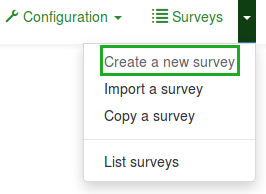
2. The second one is to click on the Surveys button located on the main toolbar of your LimeSurvey installation home page:

A survey list will be displayed. To create a new survey, click on the Create a new survey button located on the top-left part of the window, above the survey list.

Create a new survey
After you pressed Create a new survey, the following page will load:
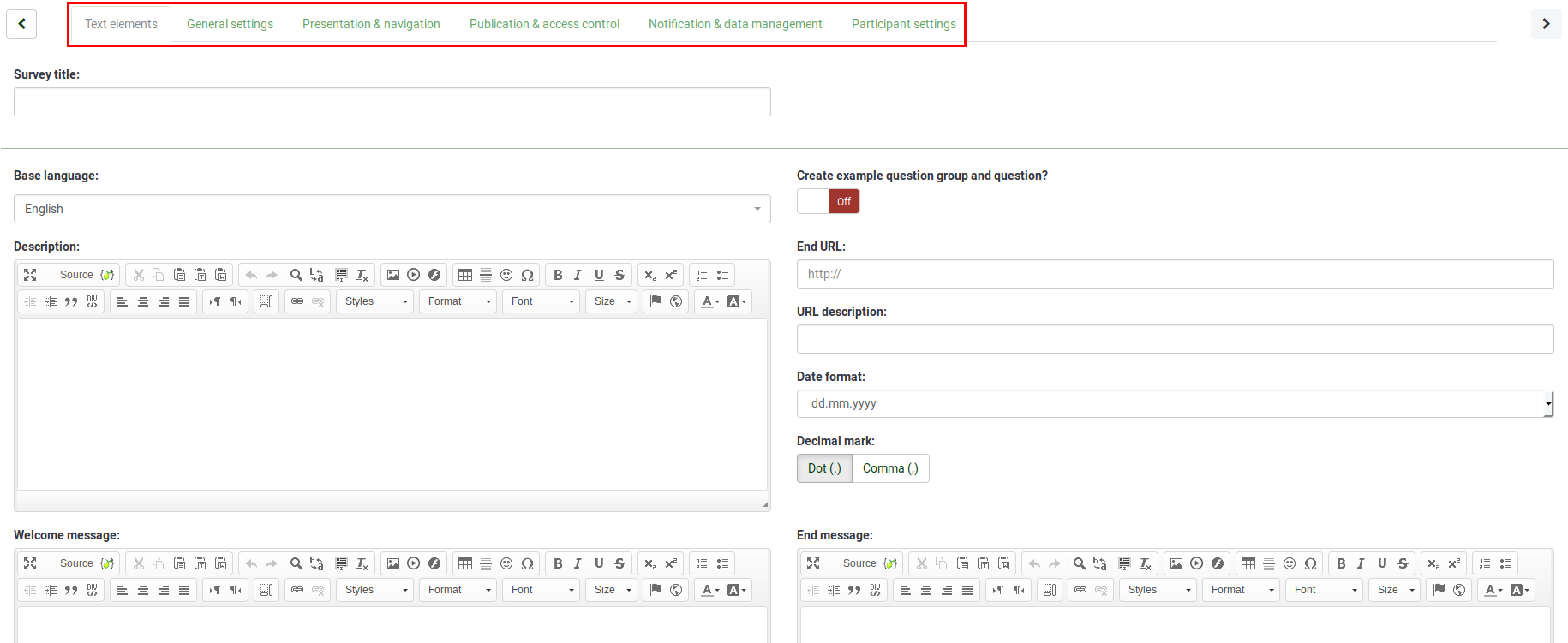
To optimize your survey, check the options available under each tab located on the Create a new survey toolbar:
- Text elements
- General settings
- Presentation & navigation
- Publication & access control
- Notification & data management
- Participant settings
Text elements
The following options are located under this tab:
- Survey title: The title of the survey can be changed from this field;
- Create example question and question group?: (New in 3.0 ) If enabled, a question and question group will be added to your survey by default when you create a survey;
- Base language: It represents the main language of the survey. If you wish to add other survey languages, create first a survey, then access the general settings of the newly created survey and add additional languages.
- Description: You can type in a survey description. If enabled from the global settings, use the HTML editor to better customize the description field;
- End URL: You have the possibility to redirect users to another page when they finish filling out the questionnaire. If you wish to redirect them, type in the URL and activate the automatically load URL option that is located under the Presentation & navigation tab;
- URL description: A short end URL description can be added in the case in which the user is redirected to a non-related survey webpage. It may help the survey administrator to add notes vis-a-vis the usage of the respective URL;
- Date format: This option is important when you want to record timestamps together with the survey participants' answers. If you click on it, a drop-down list will show up with a multitude of date formats. Choose the one that fits your survey respondents. Do not forget that different date formats are used across the world. For example, it is recommended to use a different time format if your questionnaire focuses on the US market (mm-dd-yyyy) and not on the British market (dd-mm-yy);
- Decimal mark: Two options are available: dot (.) and comma (,). Choose the one that fits the place where you conduct your study (e.g. US vs Germany);
- Welcome message: Type in a message that will welcome the survey participants when they access your survey link;
- End message: Type in a message that will be displayed to the survey participants once they finish the questionnaire. If the end URL field is automatically loaded, the end message is not displayed anymore.
General settings
The following options can be found under this tab:
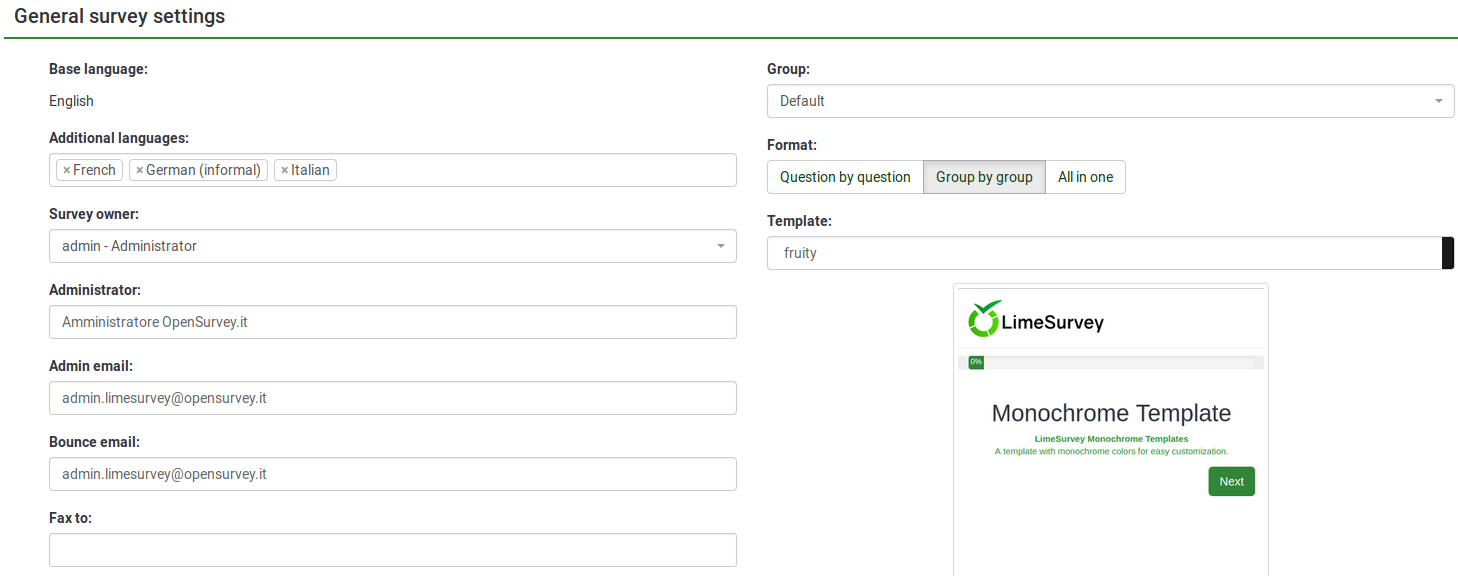
- Survey owner: Type in the real name of the survey owner;
- Administrator: The name of the administrator;
- Admin email: Type in the email of the survey administrator;
- Bounce email: This is the email address where the delivery error notification emails (bounced emails) will be sent to.
- Fax to: This field is used to print a fax number on the "printable survey" - i.e.: when you want to send someone a hard copy because he or she cannot use the online survey;
- Group (New in 3.0 ): Select the survey group the newly created survey should be added to;
- Format: It allows you to choose the way in which the questions will be displayed to the survey respondents. Three options are available:
- Question by Question : The questions will be displayed one by one (one question per page). If this option is picked up, a separate "welcome" page and "end" page will be displayed when taking the survey;
- Group by Group : Each survey page will display a question group. Also, a separate "welcome" page and "end" page will still be displayed when taking the survey, as in the "Question by Question" surveys;
- All in one : If chosen, all the pages will be displayed on a single page. If you select this option, no separate pages exist for the "welcome" and "end" pages - they will all appear on the same page, together with the questions.
- Template: The default template is rather simple, but functional. More information on creating your own templates is available here.
The following options can be found under this tab:
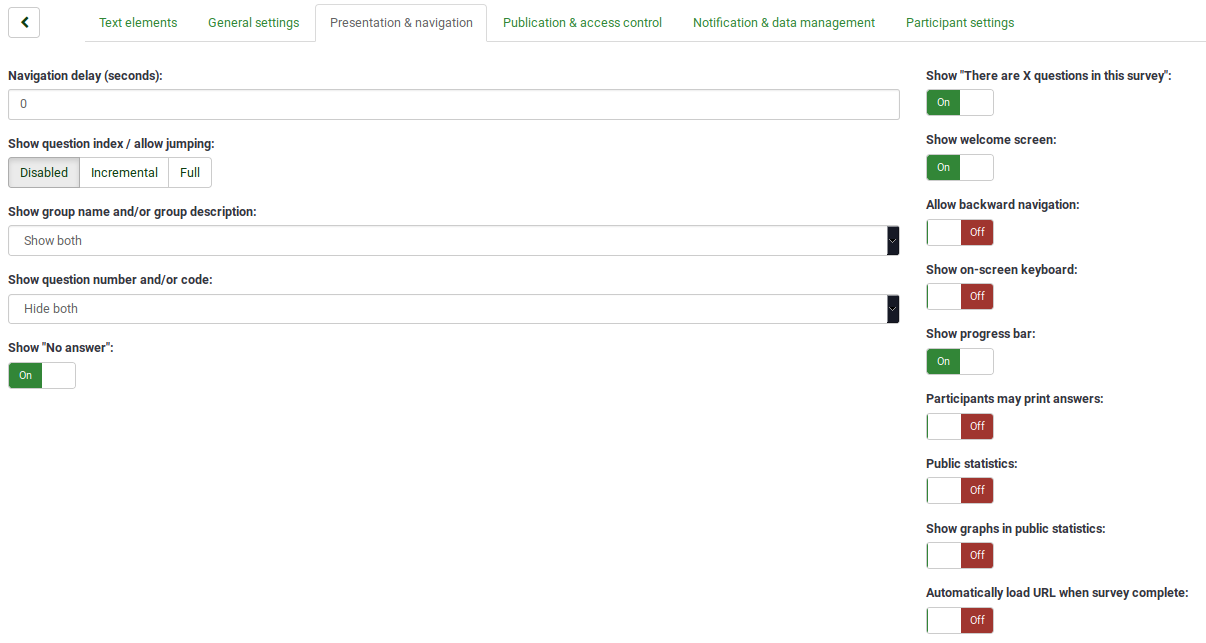
- Navigation delay (seconds): It shows the number of seconds before the previous, next, and submit buttons are enabled. If none is specified, the option will use the default value, which is "0" (seconds);
- Show question index / allow jumping: A question index can be displayed in the survey if this function is enabled, allowing the user to jump from one question group to another. You can choose the following:
- Disabled : If this option is picked up, no index is shown in the survey;
- Incremental : If this option is selected, the question groups will be shown incrementally in an index menu located on the survey page. You are allowed "to jump" only to the question groups that were previously visited/accessed;
- Full : Jumping from question group to question group is allowed via the index menu.
- Show "There are X questions in this survey: It shows the total number of questions in your survey;
- Show group name and/or group description: Your survey will show to the survey participants question groups names and/or group descriptions;
- Show question number and/or code: What to be shown to the survey participants - the question number and/or the question code, both or none. The number of the questions is shown in the moment in which someone wishes to start the survey, while the question code is shown next to each survey question;
- Show "No answer": When a radio button or select type question that contains editable answers (e.g.: List & array questions) has the Show "No answer" enabled and it is also not mandatory, an additional entry "No answer" is displayed for each question/subquestion. In this way, the respondents may choose not to answer the respective question/subquestion. As a survey administrator, the following two options are available:
- On : If this option is picked up, the respondents can choose the "no answer" option when it comes to selecting an answer for a non-mandatory question;
- Off : If selected, the "no answer" option will not be displayed as a possible answer for any non-mandatory question;
- Show welcome screen: If turned off, the welcome text message will not be displayed anymore at the beginning of the questionnaire;
- Allow backward navigation: If enabled, it will allow the users to navigate backwards and change his or her previous answers;
- Show on-screen keyboard: If turned on, an on-screen keyboard will show up when answering questions that require typing in information;
- Show progress bar: It shows to the survey participant a progress bar that emphasizes how much of the survey is filled out and how much is left to be completed;
- Participants may print answers: If turned on, the survey participants may choose at the end of the survey to print their answers;
- Public statistics: A link to a set of statistics will be shown at the end of the survey if this option is enabled;
- Show graphs in public statistics: If enabled, graphs will also be shown in the public statistics from the end of the survey. Please note that the "Public statistics option" has to be enabled to allow the survey participants see the graphs in the public statistics;
- Automatically load URL when survey complete: The end URL becomes a redirect link once the survey is completed, if this option is turned on.
Publication & access control
The following set of options is available under this tab:
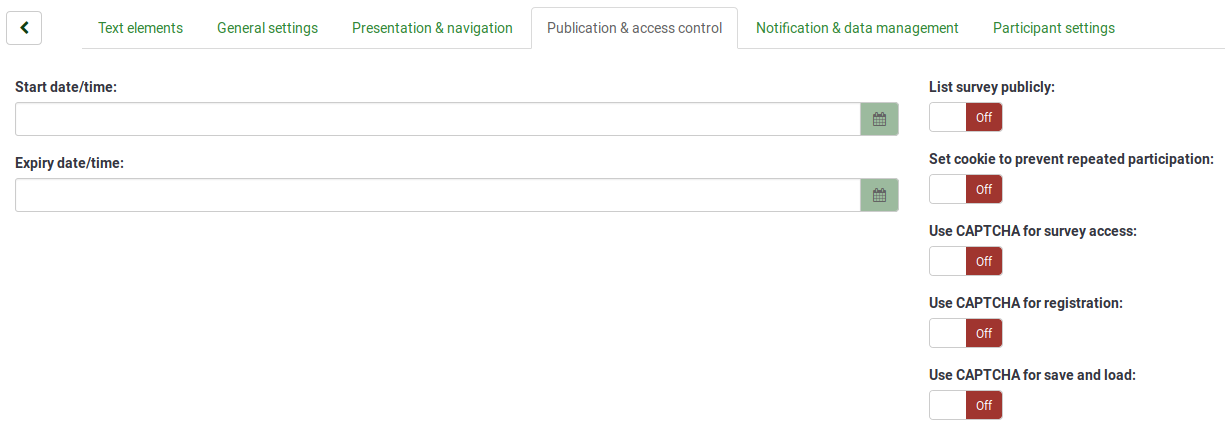
- Start date/time: The date/time the survey starts;
- Expiry date/time: Set this to some date if you want your survey to expire on a special date. This is the last date on which the public survey script will let people participate. (Example: If you set it for the 31st of December, then people will no longer be able to fill out the survey on the 1st of January). To disable this, just clear the date from the input field;
- List survey publicly: The default value is "No". When it is set to "Yes", your survey will be listed in the "available surveys" portal where it can be seen by all LimeSurvey users;
- Set cookie to prevent repeated participation: If this is turned on, a survey participant will be blocked from completing a survey for the second time;
- Use CAPTCHA for survey access: In order to access the survey, a CAPTCHA code has be typed in by the survey participant;
- Use CAPTCHA for registration: In order to register for the survey, a CAPTCHA code has be typed in by the survey participant;
- Use CAPTCHA for save and load: Enable it if you wish a survey participant to type in a CAPTCHA code when he or she loads again the survey after only a part of it was completed.
Notification & data management
The following options are available:
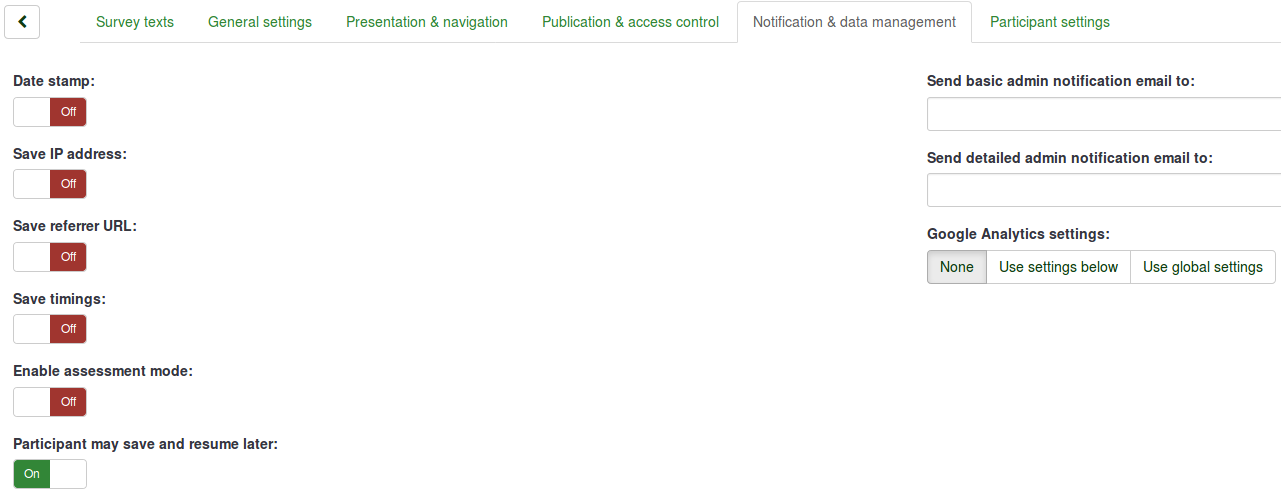
- Date stamp: Turn it on if you would like to see the time when the answers were submitted;
- Save IP address: If turned yes, the IP address of the survey respondent will be stored together with his or her answers;
- Save referrer URL: If turned yes, the referrer URL will be stored together with the answers;
- Save timings: If enabled, the time spent on each page of the survey by each survey participant is recorded;
- Enable assessment mode: You can enable/disable assessments for this survey with this setting;
- Participant may save and resume later: This setting allows a participant to save his responses and resume to answer the survey questions at a later time. Please note that this makes most sense with open surveys or surveys with anonymized answer. If you are using tokens and the survey is not anonymous, in most cases it is better to activate token-based response persistence from the Participant settings panel.
- Send basic admin notification email to and Send detailed admin notification email to: These two fields allow you to send notifications or survey responses to any email addresses once the survey is submitted. You can edit the templates for these emails from the Email templates menu. Multiple recipients can be set by separating the entries with a semicolon (;) (e.g "yourname@test.com; myname@test.com;hisname@test.com" or (if using placeholders) "yourname@test.com;{INSERTANS:82733X12X73};{TOKEN:EMAIL}").
There are different ways for entering an address:
- Enter a specific email address (ie: yourname@test.com);
- Enter a SGQA code and the response will be sent to an email address entered as an answer to that particular question (use the format {INSERTANS:9999X88X12} in the same way you would reuse information from previous answers);
- Enter a Token code (only possible if your survey is not anonymous) and the response will be sent to an email address retrieved from a token field (use the format {TOKEN:EMAIL} or {TOKEN:ATTRIBUTE_1} in the same way you would re-use Information from the Survey participants table).
- Google Analytics settings: If you would like to get further details about the survey web traffic, use Google Analytics. Three options are available:
- None : Google Analytics will not be used;
- Use settings below : If chosen, the survey owner can type in his or her Google Analytics Tracking ID to be stored only with the respective survey. You also have the possibility to choose one of the three Google Analytics styles:
- Do not use Google Analytics - so {GOOGLE_ANALYTICS_JAVASCRIPT} is an empty string;
- Default Google Analytics - {GOOGLE_ANALYTICS_JAVASCRIPT} uses the standard Google Analytics code, inserting the proper Google Analytics Key;
- SurveyName-[SID]/GroupName - {GOOGLE_ANALYTICS_JAVASCRIPT} contains customized Google Analytics code to log the URL as {SURVEYNAME}-[{SID}]/{GROUPNAME}. This can be helpful if you want to analyze navigation paths through your survey, time spent per page, and drop-off rates per page.
- Use global settings : If picked up, the survey will use the same Google Analytics Tracking ID as the one saved in the global settings and then you choose the desired Google Analytics style.
Participant settings
The following options are available:
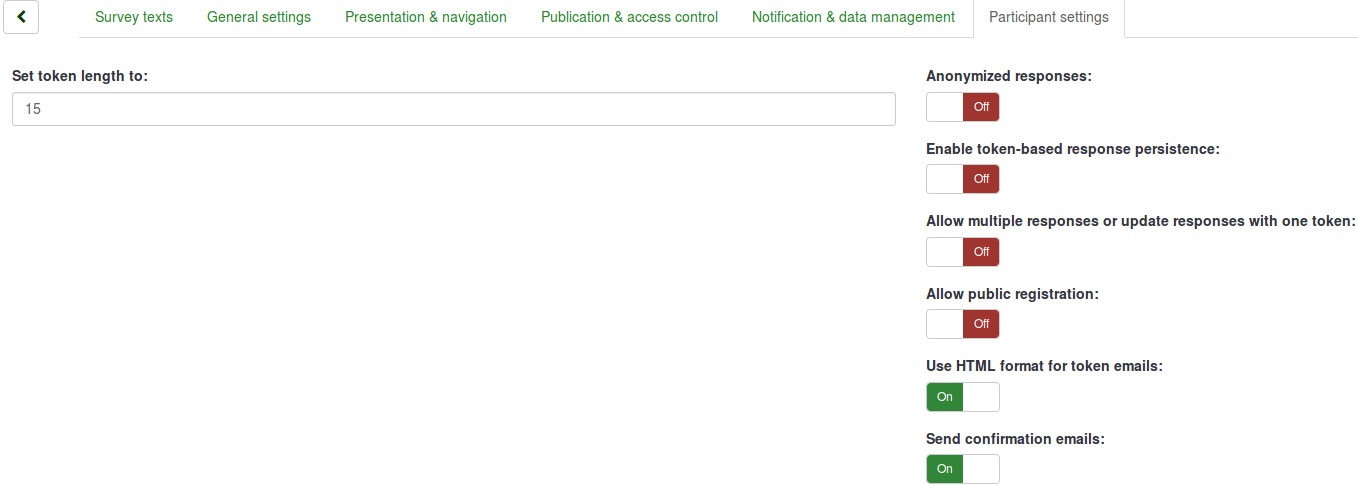
- Set token length to: Usually, the default value of 15 (max. supported value: 35) digits does not need to be changed. However, if you wish to change this setting, please enter a number (X) which is greater than 5. If the number entered is smaller than 5, it will be converted to the default value of 15. When generating tokens, all tokens will use a length of X digits;
- Anonymized responses: It allows you to determine whether responses to your survey are matched up with information from the Survey participants table (utilized in the respective survey) or are kept "anonymous". The default is "No". If you choose "Yes", then your survey is set to anonymize responses - there will be no way to connect answers and participants. Even the survey administrator will not be able to link response data and participant/token data. However, you will always be able to specifically view each response entered by your participants in the survey. Thus individual and anonymous analyses can still be done;
- Enable token-based response persistence: If your survey uses tokens and your responses are not anonymized, you may want to enable this feature. If you turn this on, your participants will be able to leave the survey and resume later at any time without using the Resume later function - for example, when they get distracted or their browser crashes. Upon clicking the invitation link again, they will find their survey answers still in place when they return to the survey and will even find themselves on the same page where they were before leaving;
- Allow multiple responses or update responses with one token: If this option is activated, participants will be able to return to their survey by clicking the invitation link, even if they have already submitted the survey. If the survey is anonymous or "Enable token-based response persistence" is set to "No", this will add a new response. If the survey is not anonymous and "Enable token-based response persistence" is enabled, the user will update the existing responses;
- Allow public registration: If you use tokens to control access to your survey, the only people who can use the survey are those who have an entry and a unique token code allocated in the Survey participants table. If you would like to use tokens, but also allow public registration, set this to "Yes". The "Yes" setting will allow visitors to register his or her name and email address. The script will create a new entry in your Survey participants table for this person, then send them an invitation email. The script will ensure that only one person per email address can complete your survey;
- Use HTML format for token emails: When enabled, all emails sent by the token management interface (invite, reminder, confirmation) will be formatted as HTML. You'll then be able to use rich formatting for these emails. The default value is "Yes";
- Send confirmation emails: If enabled, the participant will receive a confirmation email that the survey was submitted.
Import a survey
If you wish to import a survey, you can do that from the "Create, import, or copy survey" screen. To get there, click the Create, import, or copy a survey button and then on the Import tab. Next, click on browse to choose the file you wish to import, and then on the Import survey button.

The import process reads the following formats:
- .LSS files (XML-format created by LimeSurvey 1.90 or later);
- .LSA files (Survey archive which may include also token, responses and timings - available since LimeSurvey 2.0);
- .TXT files (Text-format created by Excel - available since LimeSurvey 2.0);
- .CSV files (Created by early LimeSurvey versions from 1.50 to 1.90).
The import function "intelligently" re-numbers the survey, groups, questions, answers, and condition IDs so that they all match each other. No existing survey is going to be overwritten during the import process.
By default, the resource links and expression fields are also imported. Basically, the more advanced type of questions are going to be also imported along questions that include complex branching, assessments, validation, and tailoring.
Once the import process is completed, a survey structure import summary will be displayed, showing whether it was successful or not:
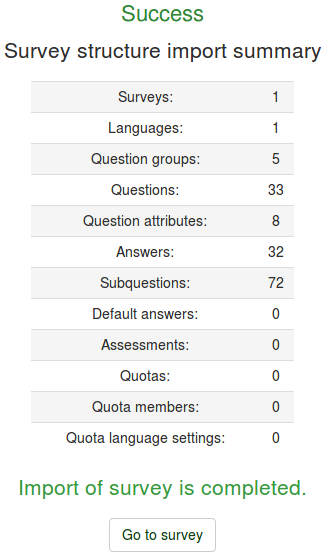
Copy a survey
The last tab contains the copy survey functionality and its options:
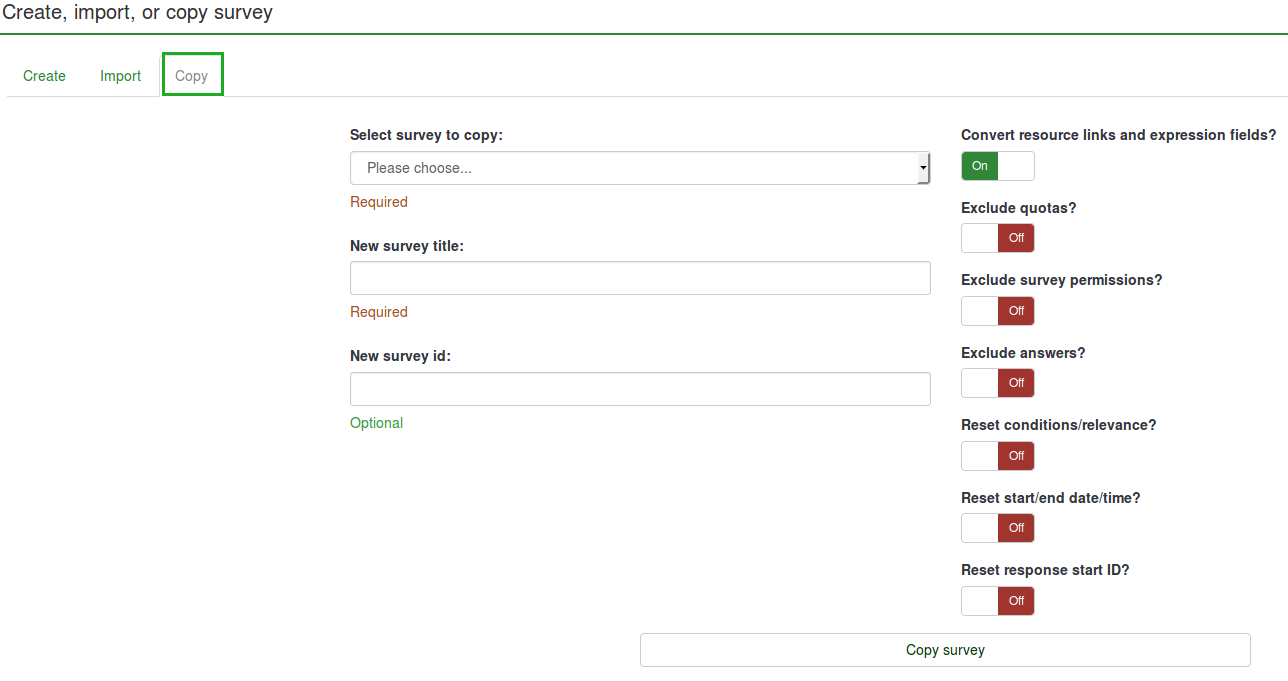
- Select survey to copy: Select from the drop-down list the survey you want to copy;
- New survey title: Type in the title you wish the copied survey to have;
- New survey id: You can complete it or let the field empty as it gets automatically assigned a survey id during the process;
- Convert resource links and expression fields: If you disable it, the more advanced question types that use the expression manager will not be copied;
- Exclude quotas: The quotas are going to be excluded if this option is disabled;
- Exclude survey permissions: If enabled, no survey permissions will be copied into the new survey;
- Exclude answers: Exclude the answer options;
- Reset conditions/relevance: Reset the conditions set in the original survey;
- Reset start/end date/time?: Reset the set start/end date/time;
- Reset response start ID?: Each response has a corresponding ID. If enabled, the ID of the responses will be reset. However, bear in mind that it is better not to have an id with two matching responses because it might influence the output of your survey.
Once you are done with the options, click on the Copy survey button located on the bottom of the page. A survey copy summary will be displayed:
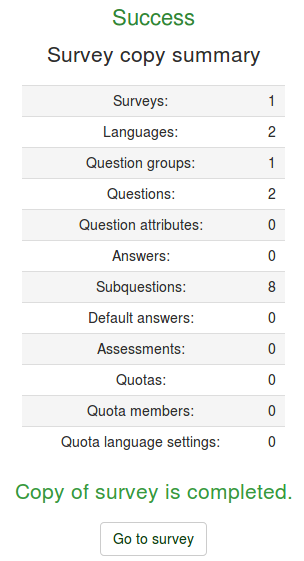
To access the copied survey, click Go to survey to be redirected to the settings of the newly added survey.
List surveys
To get an overview of all your surveys, click on the Surveys button located on the toolbar of LimeSurvey home page:

- Survey ID: When created, the survey receives a unique id that is used to make the connection between different LimeSurvey tables;
- Status: It can be:
- Title: The title of the survey;
- Group: The survey group to which the survey belongs to;
- Created: The date when the survey was created;
- Owner: The name of the user that owns the survey;
- Anonymized responses: It shows whether the responses are anonymized when stored into the database or not;
- Partial: The number of surveys that were partially completed;
- Full: The number of surveys that were fully completed by the survey participants;
- Total: The number of partially and fully completed surveys;
- Closed group: It can be either "Yes" (if a Survey participants table is used) or "No";
- Actions: The last column presents the actions that are available for each survey:

If you want to look for a specific survey, use the search bar and filter the results via the survey status field ("active", "active and running inactive", "inactive", "active but expired", and "active but not yet started").
Delete a survey
In order to delete a survey, you have to first access the survey list page. Then, select the survey(s) you wish to delete and click on the Selected survey(s)... button located on the bottom-left side of the page:
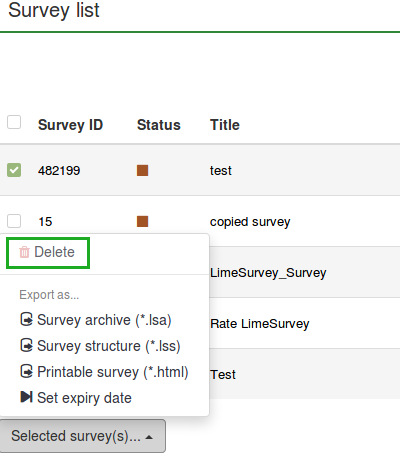
When you click Delete, a confirmation window will pop up in order to confirm your action.
Export a survey
If you want to export a survey, you have to access the survey list table and select the survey(s) you wish to export:
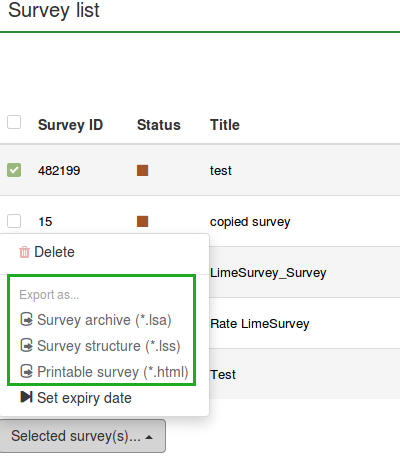
The following options are available:
- Survey archive (*.lsa);
- Survey structure (*.lss);
- Printable survey (*.html): if you would like to export the survey in a printable format in order to be filled out "offline".
For more details, check our wiki section on how to export a survey structure.
Survey groups
In order to access the survey group functionalities, click on the Surveys button located on the main toolbar of the LimeSurvey home page. Then, access Survey groups:

A survey groups list will be displayed.
On this page you can:
- Create a survey group - located above the survey groups table;
- Edit a survey group - located on the last column (the green pencil icon);
- Delete a survey group - located on the last column (the red trash icon).
Create a survey group
To add a new survey group, click on the Create a new survey group button located above the survey groups list. The following columns have to be filled in:
- Name: Type in the name of the survey group;
- Title: Type in the title of the survey group;
- Description: Type in a short description of the survey group;
- Order: Helps you organize the order of the survey groups within a parent group;
- Parent: Choose the survey group that will be the parent survey group. The parent group option is used to ease the edit of template-related options of a high number of survey groups via a few clicks.
To add surveys to the group you will need to visit the "General settings" tab inside a survey and under "Group" select the survey group.
Edit survey group
The following options of a survey group can be edited:
- Surveys in this group;
- Settings for this survey group;
- Template options for this survey group (New in 3.0 ).
Surveys in this group
If you click on the first tab, all the surveys from the respective group will be displayed.

This works as a filtering function, filtering out all the surveys not listed in the chosen survey group. You can now select the desired survey and start editing it. To see which survey-editing functionalities are available, check the list surveys section.
Settings for this survey group
The following fields can be edited from the Settings for this Surveygroup tab:
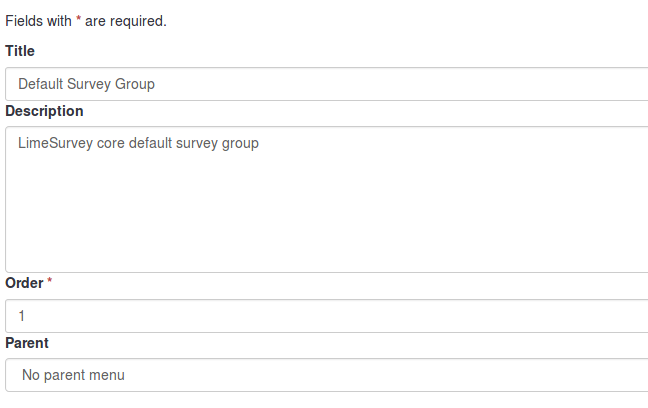
- Title: Type in the title of the survey group;
- Description: Type in a short description of the survey group;
- Order: Helps you organize the order of the survey groups within a parent group;
- Parent: Choose the survey group that will be the parent survey group. The parent group option is used to ease the edit of template-related options to a higher number of survey groups via a few clicks.
Template options for this survey group
The template options functionalities are present in LimeSurvey 3.0+. It offers a set of various options that allows you to quickly and easily change the templates-related settings of the surveys that belong to the same survey group:
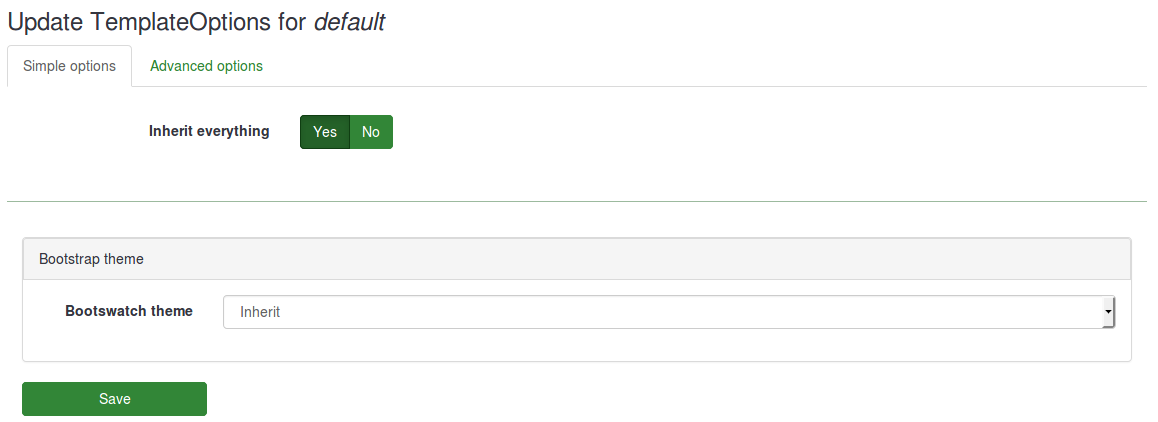
The Inherit everything functionality lets you decide whether you want the survey group to inherit everything or not from the parent survey group theme.
If you do not want this to happen, select "No". The following options will show up which will allow you to choose what should be inherited from the parent survey group theme:
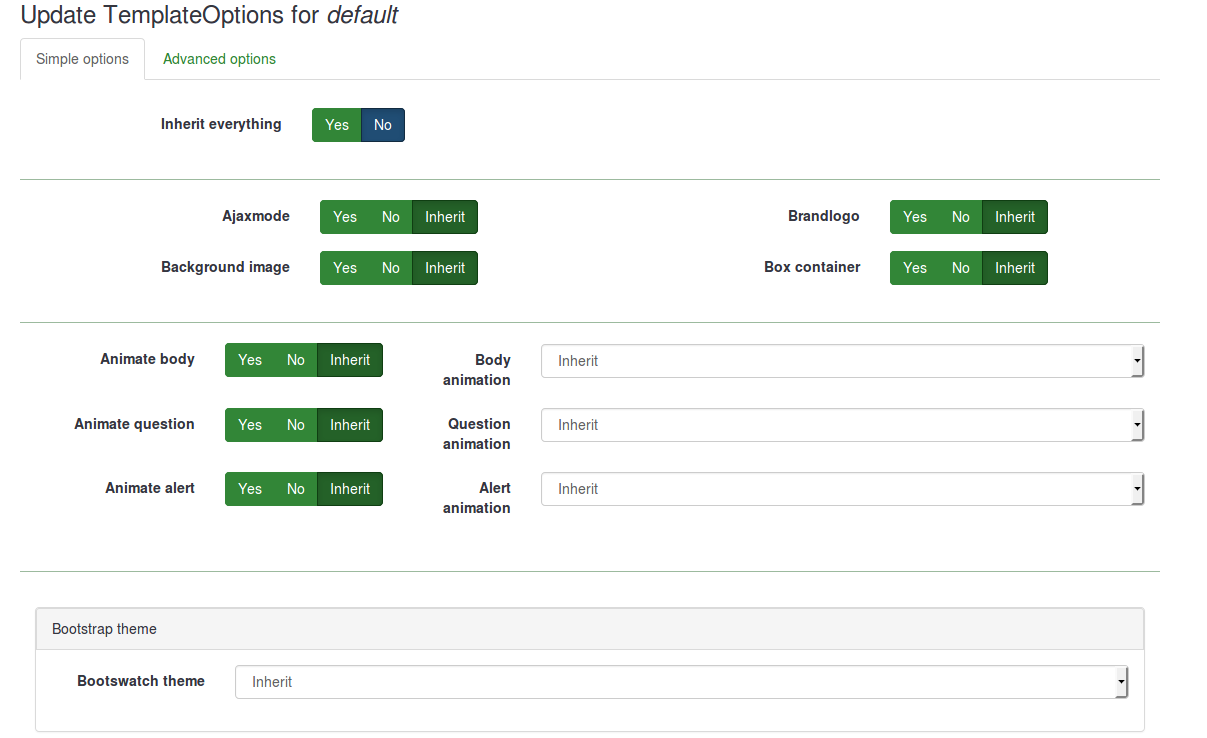
Below, you will see that you can choose a bootswatch theme for your survey group. Bootswatch themes can be used to quickly edit your templates. Basically, bootswatch is a collection of themed swatches which can be freely downloaded and dropped into your Bootstrap site. Some of these themes are already included into your LimeSurvey installation and they can be selected from the Bootswatch theme drop-down list.
If you want to tweak more a survey group template options, click on the advanced option tab (recommended for advanced users):
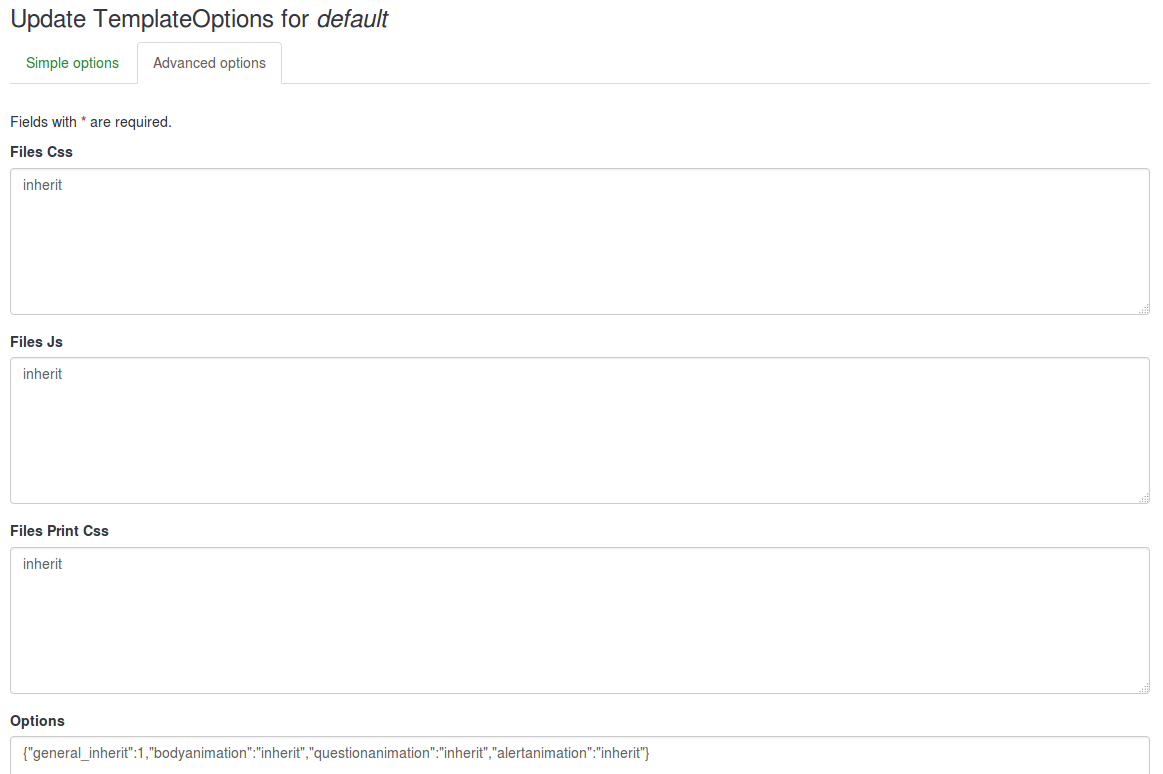
Delete a survey group
To delete a survey group, select the survey group you wish to remove and click on the red trash button located in the last column. Then, confirm the deletion.